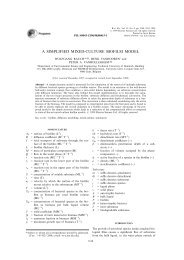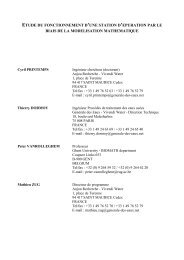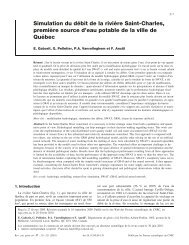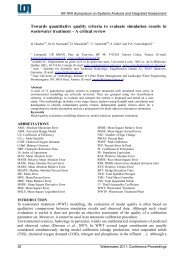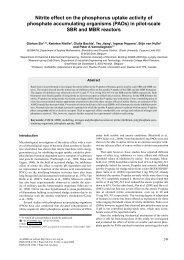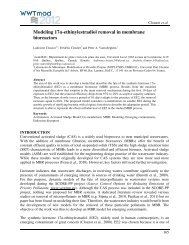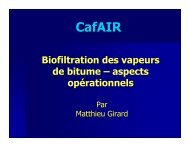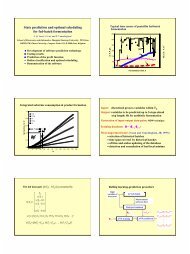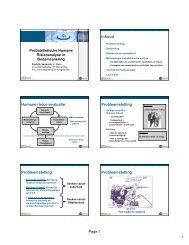Biological Phosphorus Removal Using SBR Technology :
Biological Phosphorus Removal Using SBR Technology :
Biological Phosphorus Removal Using SBR Technology :
Create successful ePaper yourself
Turn your PDF publications into a flip-book with our unique Google optimized e-Paper software.
Enhanced <strong>Biological</strong> <strong>Phosphorus</strong> <strong>Removal</strong>: Competition<br />
and symbiosis between SRBs and PAOs on lactate/acetate<br />
feed<br />
D. Baetens 1 , M. Weemaes 1 , L. Hosten 1 , P. De Vos 3 and P.A.Vanrolleghem 2<br />
1<br />
Laboratory for Technical Chemistry and Environmental Engineering, Ghent University<br />
Technologiepark 9, 9052 Ghent (Zwijnaarde), Belgium, Danielle.Baetens@vito.be<br />
2<br />
BIOMATH Department, Ghent University<br />
Coupure Links 653, B-9000 Gent, Belgium, Peter.Vanrolleghem@rug.ac.be<br />
3<br />
Laboratory for Microbiology, Ghent University,<br />
K.L. Ledeganckstraat 35, 9000 Gent, Belgium, Paul.DeVos@rug.ac.be<br />
ABSTRACT<br />
Sulphate reduction in activated sludge cultivated with a mixture of lactate and acetate as carbon source was investigated<br />
in a sequencing batch reactor. The system was initially operated to cultivate phosphorus removing<br />
bacteria using acetate as sole carbon source. Sulphate reduction was initially not observed when lactate was<br />
added as feed component, whereas the typical anaerobic/aerobic phosphorus profile was recorded. When anaerobic<br />
and aerobic cycle lengths were adjusted to allow growth of sulphate reducing bacteria, sulphate reduction<br />
was observed concurrent with complete phosphorus removal. Bulking and complete deterioration of the<br />
enhanced biological phosphorus removal was observed after several months when operating problems gave the<br />
sulphate reducing population opportunity to become dominant. Complete recovery of phosphorus removal activity<br />
was obtained after only 25 days when the operating conditions were switched back to the initial conditions.<br />
Bulking even disappeared after only 2 days. Combined sulphate reduction and phosphorus removal can<br />
be possible, provided bulking conditions of the sludge and thus wash out of the EBPR active biomass can be<br />
pre-vented.<br />
KEYWORDS<br />
Acetate feed, Enhanced <strong>Biological</strong> <strong>Phosphorus</strong> <strong>Removal</strong> (EBPR), Filamentous bulking, Lactate feed, Sequencing<br />
Batch Reactor (<strong>SBR</strong>), Sulphate reduction, Sulphate reducing bacteria<br />
INTRODUCTION<br />
With the discovery of Enhanced <strong>Biological</strong> <strong>Phosphorus</strong> <strong>Removal</strong> (EBPR) (Barnard, 1975), many wastewater<br />
treatment plants have been built with the aim to reduce phosphorus in the effluent by means of a biological<br />
rather than a chemical process. The EBPR process is supposed to achieve highest removal ratios when Short<br />
Chain Fatty Acids (SCFAs), with as key component acetate, are present in the influent (Fuhs and Chen, 1975;<br />
Potgieter and Evans, 1983; Malnou, 1984; Ekama et al., 1984; Arvin and Kristensen, 1985 and Comeau et al.,<br />
1987). Reports on the influence of non-SCFAs on the EBPR efficiency are less consistent. <strong>Using</strong> glucose or<br />
glucose/acetate as carbon sources caused in certain cases the proliferation of so called G-bacteria with a complete<br />
deterioration of EBPR activity (Cech and Hartman, 1990, 1993), whereas other authors report symbiosis<br />
between lactic acid producing bacteria and polyphosphate accumulating bacteria (PAOs) with excellent EBPR<br />
performance (Jeon and Park, 2000). Beginning of the 90'ies it was reported that anaerobic sulphate reduction<br />
caused the proliferation of filamentous bacteria with as a consequence possible hindrance of the EBPR activity<br />
(Yamamoto-Ikemoto et al. 1991, 1994). Wanner et al. (1987), however, provided evidence that inducing<br />
EBPR by enhancing growth of PAOs could suppress filamentous bulking in anaerobic-aerobic systems, even<br />
if only limited poly-P accumulation occurred.<br />
In this article evidence is gathered for deterioration of EBPR activity due to induced anaerobic sulphate reduction<br />
activity when a sequencing batch reactor (<strong>SBR</strong>) is fed with a synthetic wastewater containing lactate<br />
and acetate as carbon sources. Operating conditions obviously determine the proliferation of a filamentous<br />
population with complete washout of the PAO population.
MATERIALS and METHODS<br />
The study was carried out in a laboratory fermentor (Biostat, B. Braun, Melsinger) with a maximum volume<br />
of 11 filled with 8 of mixed liquor. To achieve EBPR the reactor was operated as a <strong>SBR</strong> with a cycle length<br />
of 6 hours: filling (15 minutes) (anaerobic), anaerobic phase (1.5 hours), aerobic phase (3 hours and 15 minutes),<br />
anaerobic in-between phase (maximum 10 minutes), during which nitrogen gas is flushed through the<br />
mixed liquor to prevent remaining oxygen entering the anaerobic period of the following cycle, settling phase<br />
(minimum 33 minutes) and an effluent purge (17 minutes). At the end of the aerobic phase 200 ml of mixed<br />
liquor is removed to obtain a sludge age of 10 days. Four litres of supernatant were removed at the end of the<br />
cycle and 4 litres of medium were fed at the beginning of the cycle, yielding a hydraulic retention time of 12<br />
hours. <strong>Using</strong> lactate/acetate mixtures, the length of the aerobic phase was increased by 2 hours in order to obtain<br />
complete phosphorus removal. To promote growth of SRBs, the length of the anaerobic phase was increased<br />
to 2 hours and 45 minutes and the length of the aerobic phase was shortened to 2 hours and 15 minutes.<br />
The feed compositions and phase lengths during the different research periods are presented in Table 1.<br />
Table 1 Feed compositions and phase lengths during the different research periods<br />
Acetate<br />
[g COD/]<br />
Lactate<br />
[g COD/]<br />
Ortho-P<br />
[mg P/]<br />
Anaerobic phase<br />
length<br />
Aerobic phase<br />
length<br />
Duration<br />
[days]<br />
1 st research period 400 - 15 1h30min 3h15min 136<br />
2 nd research period 800 - 15 1h30min 3h15min 22<br />
3 rd research period 800 - 45 1h30min 3h15min 10<br />
4 th research period* 800 - 45 1h30min 5h15min 4<br />
5 th research period 400 400 45 1h30min 5h15min 24<br />
6 th research period 400 400 15 2h45min 2h15min 116<br />
7 th research period 400 - 15 1h30min 3h15min …..<br />
* All other nutrients were doubled in concentration<br />
The unit was sampled twice a week to verify the phosphorus removal capacity. For this purpose, samples<br />
were taken at least at the end of the previous cycle in the settling phase, at the end of the feeding phase, at the<br />
end of the anaerobic phase and at the end of the aerobic phase. All samples were then analysed at least for<br />
ortho-P, nitrate and MLSS. COD, PHA and sulphate were analysed less frequently. When experiments were<br />
performed to elucidate the kinetics of the different reactions, at least 30 samples were taken during the anaerobic<br />
and aerobic phase of one cycle. Samples were then analysed for ortho-P, COD, nitrate, sulphate and<br />
PHA.<br />
RESULTS and DISCUSSION<br />
The <strong>SBR</strong> was initially operated to enhance biological phosphorus removal with acetate as the sole carbon<br />
source (400 mg COD/) and 15 mg P/ ortho-phosphate. The initial cycle lengths, i.e. an anaerobic phase of 1<br />
hour and 30 minutes and an aerobic phase of 3 hours and 15 minutes, were used for low acetate concentration.<br />
It was observed that full phosphorus removal could still be achieved using a higher acetate concentration, only<br />
by increasing the length of the aerobic phase with 2 hours. No acetate breakthrough to the aerobic phase occurred.<br />
Higher phosphorus and PHA concentrations were reached at the end of the anaerobic phase compared<br />
to the first research period.<br />
Table 1 Ortho-P release to COD uptake ratios, PHA formation to COD uptake and PHV to PHB ratios<br />
Period<br />
No of<br />
days<br />
elapsed<br />
Carbon source<br />
in feed<br />
[mg COD/]<br />
Ortho-P<br />
in feed<br />
[mg P/]<br />
Ortho-P release<br />
to COD uptake<br />
[mg P/mg COD]<br />
(PHB+PHV) formation<br />
to COD uptake<br />
[mg PHA/mg COD]<br />
PHV/PHB<br />
ratio<br />
[-]<br />
P-removal<br />
ratio<br />
[%]<br />
1 st 36 547 (acetate) 12.998 0.142 0.334 + 0.063 = 0.397 0.188 100<br />
1 st 43 319 (acetate) 12.880 0.209 0.365 + 0.089 = 0.454 0.244 84<br />
1 st 80 220 (acetate) 12.760 0.665 1.020 + 0.304 = 1.324 0.298 64<br />
2 nd 18 573 (acetate) 13.371 0.744 2.463 + 0.868 = 3.331* 0.353 100<br />
3 rd 5 751 (acetate) 39.581 0.404 0.771 + 0.241 = 1.012 0.312 72<br />
4 th 1 851 (acetate) 42.251 0.376 0.837 + 0.236 = 1.073 0.282 100<br />
5 th 16 lactate/acetate 38.50 n.m. n.m. 1.019 47<br />
6 th 14 785 lactate/acetate 10.07 0.209 n.m. 1.17 100<br />
6 th 15 lactate/acetate low (~ 15) n.m. n.m. 0.990 0<br />
* See further, this value is too high. Most probably the COD measurement was not correct. n.m.: not measured
From Table 2 it can be observed that the higher the acetate concentration in the feed, the higher the observed<br />
phosphorus release and PHB formation during the anaerobic phase. When increased concentration of carbon<br />
sources are used, the PHA-formation to carbon utilisation ratio increases. The PHV/PHB ratio remains nearly<br />
constant. During the 5 th research period a mixture of acetate and lactate was used as carbon source. Only after<br />
as few as 6 days, complete phosphorus removal could no longer be obtained. However, an anaerobic/aerobic<br />
phosphorus profile was still recorded, whereas still no sulphate profile was observed. It could be deduced that<br />
using a 50/50w% lactate/acetate mixture as carbon source had almost no effect on the maximum anaerobic<br />
phosphorus concentration compared to acetate alone. However, the PHV/PHB ratio increased from about 0.3<br />
for pure acetate feed to about 1 for the mixture of acetate and lactate (Table 2).<br />
PHB/PHV (%PHA)<br />
7<br />
6<br />
5<br />
4<br />
3<br />
2<br />
1<br />
0<br />
0 50 100 150 200 250 300<br />
Time (min)<br />
Phosphate<br />
PHB<br />
PHV<br />
Sulphate<br />
Figure 1 PHB/PHV and ortho-P profiles for lactate/acetate<br />
feed (50/50) after 13 days of acclimation to the<br />
6 th research period.<br />
160<br />
140<br />
120<br />
100<br />
80<br />
60<br />
40<br />
20<br />
0<br />
Ortho-P (mg P/l)<br />
Increasing the length of the anaerobic<br />
phase to 2 hours and 45 minutes and<br />
shortening the aerobic phase to 2 hours<br />
and 15 minutes, anaerobic sulphate reduction<br />
was clearly observed (Figure 1).<br />
From the experimental results it was obvious<br />
that most of the carbon source was<br />
already used during the feeding phase (not<br />
shown). In this phase of the process, the<br />
sulphate reduction is only minor compared<br />
to the reduction in the true anaerobic<br />
phase. Sufficient carbon source thus<br />
remains for PAOs. These results indicate<br />
that sulphate reduction and phosphorus<br />
removal occur simultaneously.<br />
One month after the operating and feeding conditions were changed to enhance sulphate reduction, the typical<br />
phosphorus profile and complete phosphorus removal were still present. However, the sludge showed very bad<br />
settling characteristics, i.e. the SVI changed from 10 ml/g to more than 500 ml/g. Due to growth of biomass on<br />
the membrane of the pH electrode, a pH value of 8.8 occurred for a period of at maximum 2 weeks. After this<br />
period, the biomass did not settle at all and biomass was washed out with the effluent. As a result phosphorus<br />
was no longer removed.<br />
Finally, the feeding of lactate was ceased to enhance phosphorus removal again. It was observed that only after<br />
as few as 99 cycles, i.e. 25 days (3 sludge ages), complete phosphorus removal capacity was regained. The sulphate<br />
reduction capacity of the sludge completely disappeared after only two days and at the same moment the<br />
sludge's settling characteristics improved drastically.<br />
During the second start-up period of the EBPR process, the biomass was observed microscopically. Starting<br />
from a sludge with nearly only filamentous bacteria a bacterial population was created with clear inclusions of<br />
intracellular storage polymers. Initially the sludge had very poor settling characteristics with a SVI of over<br />
500 ml/g. The population consisted of filamentous bacteria belonging to Beggiatoa spp. It was observed that the<br />
biomass immediately responded to the changed operating conditions and growth started of two clearly different<br />
microbial populations. At the moment the <strong>SBR</strong> had fully restored its phosphorus removal capacity, the population<br />
containing storage polymers dominated, however, the growth of the second population continued and possible<br />
symbiosis between both occurred.<br />
Although the experimental evidence gained provides proof that SRBs and PAOs can co-exist under defined<br />
conditions, it was also shown that this co-habitation is vulnerable and dominant growth of filamentous bacteria<br />
as Beggiatoa spp. can completely suppress the EBPR activity. Although Eikelboom (2000) indicated four filamentous<br />
species known to store elemental sulphur granules inside their cells, i.e. Thiotrix spp., Beggiatoa spp.,<br />
Type 021N and Type 0914, they stated that Beggiatoa spp. is rather uncommon in activated sludge plants. In<br />
1994, Yamamoto-Ikemoto et al. proposed a model for the possible ecological interactions among SRBs, PAOs,<br />
denitrifying bacteria and filamentous sulphur bacteria based on own experimental evidence and general microbial<br />
knowledge (Yamamoto-Ikemoto et al., 1991, 1994, 1996) (Figure 2). Denitrifying conditions suppress the<br />
growth of sulphate reducing bacteria because of the competition for the available carbon source. In the absence<br />
of denitrifiers, the authors observed sulphate reduction in wastewater treatment.<br />
14<br />
12<br />
10<br />
8<br />
6<br />
4<br />
2<br />
0<br />
Sulphate (mg S/l)
According to Yamamoto-Ikemoto et al. (1991), deterioration of EBPR activity was linked with high sulphate<br />
reduction producing high concentration of sulphide. The high sulphide concentration induced growth of filamentous<br />
bacteria, i.e. Beggiatoa spp. Consequently, the longer the sulphate reduction activity, the higher the<br />
phosphate concentration observed in the effluent. Whereas sulphide was never observed in our system, except<br />
for the times when nitrogen bubbling was deliberately switched off, growth of filamentous bacteria was clearly<br />
observed. Fast uptake of sulphide by the microbial population is a possible explanation for the sulphide profile<br />
to be absent.<br />
Competition<br />
Denitrifying<br />
bacteria<br />
Sulphate reducing<br />
bacteria<br />
Competition<br />
HS -<br />
SO 4<br />
Poly-P accumulating<br />
bacteria<br />
Hindrance by strong<br />
sulphate reduction<br />
Filamentous sulphur<br />
bacteria<br />
Figure 2 Model of ecological interactions among denitrifying bacteria, PAOs, SRBs and filamentous sulphur<br />
bacteria in activated sludge (after Yamamoto-Ikemoto et al., 1994)<br />
CONCLUSIONS<br />
Simultaneous occurrence of anaerobic sulphate reduction and phosphorus release was possible, but proved to be<br />
a process vulnerable to fast deterioration of EBPR activity due to changed operating conditions. Growth of<br />
filamentous bacteria, with Beggiatoa spp. as dominant organism, was always observed concurrent with sulphate<br />
reduction, even at low levels. It is expected that the higher the sulphate reduction, the more dominant the<br />
growth of these filamentous bacteria will become, with fast deterioration of EBPR.<br />
It was observed that PAO activity was suppressed, but could very quickly restore its acetate uptake and overall<br />
P-removal capacity. Regrowth of PAOs allowed complete recovery of EBPR activity within 3 sludge ages.<br />
REFERENCES<br />
Arvin, E. and Kristensen, G.H. Exchange of organics, phosphate and cations between sludge and water in biological phosphorus and<br />
nitrogen removal processes. Wat. Sci. Tech., 17(11/12), 147-162 (1985)<br />
Barnard, J.L. <strong>Biological</strong> nutrient removal without the addition of chemicals. Wat. Res., 9, 485-490 (1975)<br />
Cech, J. S. and Hartman, P. Glucose induced breakdown of enhanced biological phosphate removal. Environ. Technol., 11, 651-656<br />
(1990)<br />
Cech, J. S. and Hartman, P. Competition between polyphosphate and polysaccharide accumulating bacteria in enhanced biological<br />
phosphate removal systems. Wat. Res., 27(7), 1219-1225 (1993)<br />
Comeau, Y., Oldham, W.K. and Hall, K.J. Dynamics of carbon reserves in biological dephosphation of wastewater. Proc. IAWPRC<br />
Int. Conf. on <strong>Biological</strong> Phosphate <strong>Removal</strong> from Wastewaters, Rome, Italy Adv. Water Pollut. Cont. (ed. Ramadori), 39-55 (1987)<br />
Eikelboom, D.H. Sulfur-storing bacteria and bulking of activated sludge. In Environmental technologies to treat sulfur pollution, principles<br />
and engineering, 449-466 (ed. Lens and Pol), 1 st Ed., IWA Publishing, London, UK (2000)<br />
Ekama, G.A. and Marais, G.v.R. Influence of wastewater characteristics on process design. In: Theory, design and operation of nutrient<br />
removal activated sludge processes., 3, 1-10 (Water Research Commission) Pretoria, South Africa (1984)<br />
Fuhs, G.W. and Chen, M. Microbiological basis of phosphate removal in the activated sludge process for treatment of wastewater.<br />
Microbiol. Ecol., 2(2), 119-138 (1975)<br />
Jeon, C.O. and Park, J.M. Enhanced biological phosphorus removal in a sequencing batch reactor supplied with glucose as a sole carbon<br />
source. Wat. Res., 34(7), 2160-2170 (2000)<br />
Malnou, D., Meganck, M., Faup, G.M. and du Rostu, M. <strong>Biological</strong> phosphorus removal: study of the main parameters. Wat. Sci.<br />
Tech., 16(10/11) (1984)<br />
Potgieter, D.J.J. and Evans, B.W. Biochemical changes associated with luxury phosphate uptake in a modified phoredox activated<br />
sludge system. Wat. Sci. Tech., 15(2/3), 105-116 (1983)<br />
Wanner, J. and Grau, P. Filamentous bulking in nutrient removal activated sludge systems. Wat. Sci. Tech., 21(4/5), 1-8 (1987)<br />
Yamamoto-Ikemoto, R., Komori, T. and Matsui, S. Filamentous bulking and hindrance of phosphate removal due to sulphate reduction<br />
in activated sludge. Wat. Sci. Tech., 23(Kyoto), 927-935 (1991)<br />
Yamamoto-Ikemoto, R., Matsui, S. and Komori, T. Ecological interactions among denitrification, poly-P accumulation, sulfate reduction,<br />
and filamentous sulfur bacteria in activated sludge. Wat. Sci. Tech., 30, 201-210 (1994)<br />
Yamamoto-Ikemoto, R., Matsui, S., Komori, T. and Bosque-Hamilton, E.J. Symbiosis and competition among sulfate reduction, filamentous<br />
sulfur, denitrification, and poly-P accumulation bacteria in the anaerobic-oxic activated sludge of a municipal plant18th<br />
IAWQ Biennial International Conference, Singapore (1996)



